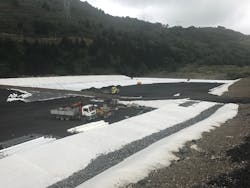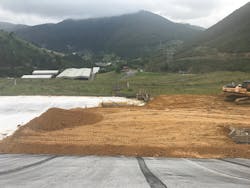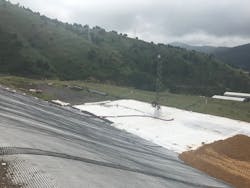Silver Lining in Northern Spain
About the author:
Michael T. Kozak, J.D. is the Vice President, Building Materials & Environmental Products for Minerals Technologies, Inc. (CETCO is a wholly owned subsidiary of Minerals Technologies Inc. [NYSE: MTX]). Kozak can be reached at [email protected].
Designing a new lining project is anything but straightforward. It is not a matter of simply measuring and applying; rather, it requires identifying the type of waste that will be disposed. In addition, the chemical composition of the subgrade onto which the lining materials will be applied also must be analyzed. Anticipating chemical compatibility issues is just one of the many factors considered for providing the long-term success of a liner system.
Project designers of the MSW landfill project in Northern Spain learned this firsthand when designing a massive (44,000 square meters) new cell. After testing soils recovered from construction and demolition waste (RCD), project workers found high concentrations of calcium salts. The presence of these compounds made selecting a standard geosynthetic clay liner (GCL) untenable, as the calcium ion concentration would negatively impact the hydraulic conductivity of the sodium bentonite.
Consultants reached out to CETCO for assistance as it has decades of experience with lining systems. These systems also are a part of a larger, comprehensive portfolio of solutions for global construction, mining and environmental service industries.
These patented products include hydraulic barriers used for difficult to manage leachates, as well as contaminated sediment capping materials and gas and vapor intrusion control products. The environmental products are designed around chemical compatibility and geotechnical requirements of customers’ projects. Over the past 25 years, these solutions have been integral for construction, remediation and environmental projects in dozens of countries around the world.
The Solution
The project designers explained their challenges to CETCO technical consultants, and expressed their need for a customized GCL formulation. The customer needed a high level of chemical resistance for the GCL when installed under the specific conditions found at the site.
Working with the information and data provided by the customer, CETCO arrived at its Resistex GCL, one of several “specialty GCLs” in the company’s portfolio of lining technology options. This liner met the specific performance requirements for this project and is a geosynthetic product consisting of a proprietary polymer-modified sodium bentonite layer needle punched between two geotextile fabrics.
The recommended product was tailored to provide an economic, high-performance hydraulic barrier for the landfill’s aggressive leachate environment. The GCLs are designed to be compatible with a wide range of pH, electrical conductivity and ionic strengths. These products have proved to be more effective than standard bentonite GCL’s when deployed in contaminated chemical environments or situations with highly specific compatibility requirements. The Resistex-100 GCL was the specific product used for the site.
Lining Success
Installation was performed quickly in light of the challenging environment, and in total, 44,000 square meters of the GCL with polymer modified bentonite (PMB) was installed to address both the chemical compatibility and geotechnical design requirements over a period of three months (roughly 1,500 square meters per day).


